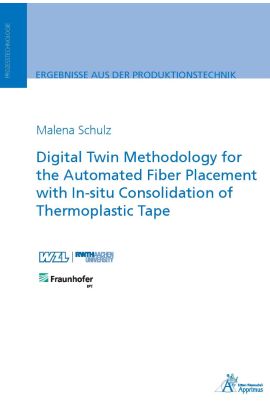The automated fiber placement (AFP) process of thermoplastic tape with in-situ consolidation is a promising technology to enable a resource-efficient production of load-optimized, near-net shape lightweight parts. However, it is prone to difficult processing due to its complexities and interacting parameters. This results in time-consuming experiments generating a lot of resource-consuming waste. To prevent this from happening and to make the production process more resource-efficient and simpler, a realistic process modeling within a digital twin can be a solution. For this reason, this thesis develops a methodology for a digital twin for the AFP process of thermoplastic, tailored composites blanks.
In the last decades, a vast process knowledge has been gained in research offering a bouquet of validated modeling solutions for the AFP process. Within this thesis, a detailed study leads to the selection of adequate models for the transfer into a digital twin. The temperature evolution within the laminate during processing is a crucial characteristic. It strongly influences the quality of the final part. Quality indicators, such as the consolidation degree and crystallization ratio, are based on well-established analytical models. A first feasibility study of applying these models to gain a more part-oriented, realistic model shows the potentials for the digital twin. Based on its findings, a digital twin is proposed by specifying the required information, the suitable models as well as additional part-oriented characteristics, such as the path-dependent cooling time.
An experimental validation of the proposed digital twin is conducted on the AFP pro-duction system, PrePro2D®. Due to is fully integrated hardware, the system allows to smoothly assess, synchronize, and store all relevant data without the need of further data preparation. Although various material characteristics are taken from literature, the validation shows good agreement with the digital twin prediction. However, it also gives insight into the gaps of the model. The aggregation of information to capture a holistic process view still incorporates many underlying assumptions. This thesis summarizes with an overview of solutions improving the prediction quality of the digital twin. In conclusion, this dissertation elaborates a new solution space for complex manufacturing problems of the FRP industry with the help of digitization.
| Autor | Schulz, Malena |
|---|---|
| Gewicht | 0.286 kg |
| Erscheinungsdatum | 30.01.2024 |
Eigene Bewertung schreiben
Prozesstechnologie
Digital Twin Methodology for the Automated Fiber Placement with In-situ Consolidation of Thermoplastic Tape
ISBN: 978-3-98555-195-8
Lieferzeit: 2-3 Tage
49,00 €
inkl. 7% MwSt.
Kurzbeschreibung
The automated fiber placement (AFP) process of thermoplastic tape with in-situ consolidation is a promising technology to enable a resource-efficient production of load-optimized, near-net shape lightweight parts. However, it is prone to difficult processing due to its complexities and interacting parameters. This thesis analyses and validates a methodology for a digital twin for the AFP process of thermoplastic, tailored composites blanks to enable a realistic, part-oriented process modeling.
Auf Lager

